.
2.10.2015
Rosetta’s First Peek at the Comet’s Dark Side
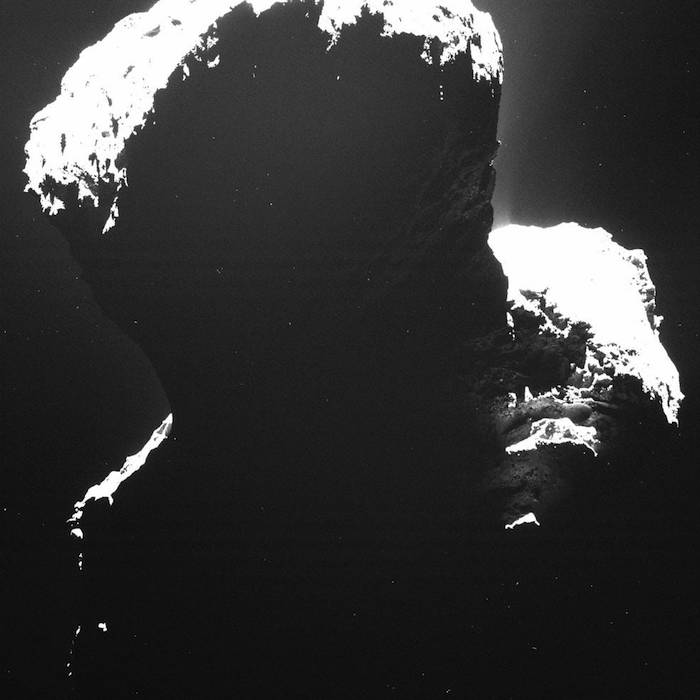
Image of the southern polar regions of comet 67P/Churyumov-Gerasimenkotaken was taken by Rosetta's Optical, Spectroscopic, and Infrared Remote Imaging System (OSIRIS) on September 29, 2014, when the comet was still experiencing the long southern winter.
Credits: ESA/Rosetta/MPS for OSIRIS Team
.
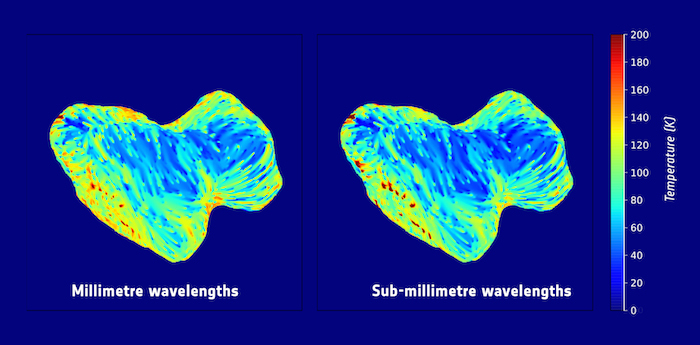
Subsurface temperature maps of 67P/Churyumov–Gerasimenko, showing the southern hemisphere of the comet. The maps are based on observations obtained with the Microwave Instrument for the Rosetta Obiter (MIRO) at millimeter (left) and sub-millimeter (right) wavelengths between September and October 2014. The MIRO data are projected on a digital shape model of the comet. A temperature bar (in degrees Kelvin), is to the right.
Credits: ESA/Rosetta/NASA/JPL-Caltech
.
Since its arrival at comet 67P/Churyumov-Gerasimenko, the European Space Agency's Rosetta spacecraft has been surveying the surface and the environment of this curiously shaped body. But for a long time, a portion of the nucleus -- the dark, cold regions around the comet's south pole -- remained inaccessible to almost all instruments on the spacecraft.
Due to a combination of its double-lobed shape and the inclination of its rotation axis, Rosetta's comet has a very peculiar seasonal pattern over its 6.5-year-long orbit. Seasons are distributed very unevenly between the two hemispheres. Each hemisphere comprise parts of both comet lobes and the "neck."
For most of the comet’s orbit, the northern hemisphere experiences a very long summer, lasting over 5.5 years, while the southern hemisphere undergoes a long, dark and cold winter. However, a few months before the comet reaches perihelion -- the closest point to the sun along its orbit -- the situation changes, and the southern hemisphere transitions to a brief and very hot summer.
When Rosetta arrived at 67P/C-G in August 2014, the comet was still experiencing its long summer in the northern hemisphere, and regions on the southern hemisphere received very little sunlight. Moreover, a large part of this hemisphere, close to the comet’s south pole, was in polar night and had been in total darkness for almost five years.
With no direct illumination from the sun, these regions could not be imaged with Rosetta’s OSIRIS (the Optical, Spectroscopic, and Infrared Remote Imaging System) science camera, or its Visible, InfraRed and Thermal Imaging Spectrometer (VIRTIS). For the first several months after Rosetta’s arrival at the comet, only one instrument on the spacecraft could observe and characterize the cold southern pole of 67P/C-G: the Microwave Instrument for Rosetta Orbiter (MIRO).
In a paper accepted for publication in the journal Astronomy and Astrophysics, scientists report on the data collected by MIRO over these regions between August and October 2014.
"We observed the 'dark side' of the comet with MIRO on many occasions after Rosetta’s arrival at 67P/C-G, and these unique data are telling us something very intriguing about the material just below its surface," said Mathieu Choukroun from NASA's Jet Propulsion Laboratory (JPL), Pasadena, California, lead author of the study.
Observing the comet’s southern polar regions, Choukroun and colleagues found significant differences between the data collected with MIRO’s millimeter and sub-millimeter wavelength channels. These differences might point to the presence of large amounts of ice within the first few tens of centimeters below the surface of these regions.
"Surprisingly, the thermal and electrical properties around the comet’s south pole are quite different than what is found elsewhere on the nucleus," said Choukroun. "It appears that either the surface material or the material that’s a few tens of centimeters below it is extremely transparent, and could consist mostly of water ice or carbon-dioxide ice."
The difference between the surface and subsurface composition of this part of the nucleus and that found elsewhere might originate in the comet’s peculiar cycle of seasons. One of the possible explanations is that water and other gases that were released during the comet’s previous perihelion, when the southern hemisphere was the most illuminated portion of the nucleus. The water condensed again and precipitated on the surface after the season changed and the southern hemisphere plunged again into its long and cold winter.
These are, however, preliminary results, because the analysis depends on the detailed shape of the nucleus. At the time the measurements were made, the shape of the dark, polar region was not known with great accuracy.
"We plan to revisit the MIRO data using an updated version of the shape model, to verify these early results and refine the interpretation of the measurements," added Choukroun.
Rosetta scientists will be testing these and other possible scenarios using data that were collected in the subsequent months, leading to the comet's perihelion, which took place on Aug. 13, 2015 and beyond.
In May 2015, the seasons changed on 67P/C-G and the brief, hot southern summer, which will last until early 2016, began. As the formerly dark southern polar regions started to receive more sunlight, it has been possible to observe them with other instruments on Rosetta, and the combination of all data might eventually disclose the origin of their curious composition.
"In the past few months, Rosetta has flown over the southern polar regions on several occasions, starting to collect data from this part of the comet after summer began there,” said Matt Taylor, ESA Rosetta project scientist. "At the beginning of the southern summer, we had a paucity of observations in these regions as Rosetta's trajectory focused on the northern hemisphere due to ongoing communication with the lander, Philae. However, closer to perihelion we were able to begin observing the south."
Rosetta is currently on an excursion out to about 930 miles (1,500 kilometers) from the nucleus to study the comet's environment at large. But the spacecraft will soon come closer to the comet, focusing on full orbits to compare the northern and southern hemispheres, as well as some slower passes in the south to maximize observations there. In addition, as activity will start to wane later this year, the team hopes to get closer to the nucleus and gain higher-resolution observations of the surface.
"First, we observed these dark regions with MIRO, the only instrument able to do so at the time, and we tried to interpret these unique data. Now, as these regions became warmer and brighter around perihelion, we can observe them with other instruments, too."
Mark Hofstadter, MIRO principal investigator at JPL, adds, "We hope that, by combining data from all these instruments, we will be able to confirm whether or not the south pole had a different composition and whether or not it is changing seasonally."
The MIRO instrument is a small, lightweight spectrometer that can map the abundance, temperature and velocity of cometary water vapor and other molecules that the nucleus releases. It can also measure the temperature up to about one inch (three centimeters) below the surface of the comet's nucleus. One reason the subsurface temperature is important is that the observed gases likely come from sublimating ices beneath the surface. By combining information on the gas and the subsurface, MIRO is able to study this process in detail.
Comets are time capsules containing primitive material left over from the epoch when the sun and its planets formed. Rosetta is the first spacecraft to witness at close proximity how a comet changes as it is subjected to the increasing intensity of the sun's radiation. Observations will help scientists learn more about the origin and evolution of our solar system and the role comets may have played in the formation of planets.
Rosetta is an ESA mission with contributions from its member states and NASA. Rosetta's Philae lander is provided by a consortium led by the German Aerospace Center, Cologne; Max Planck Institute for Solar System Research, Gottingen; French National Space Agency, Paris; and the Italian Space Agency, Rome. JPL, Pasadena, California, a division of the California Institute of Technology in Pasadena, manages the U.S. contribution of the Rosetta mission for NASA's Science Mission Directorate in Washington. JPL also built the MIRO and hosts its principal investigator, Mark Hofstadter. The Southwest Research Institute (San Antonio and Boulder, Colorado), developed the Rosetta orbiter's IES and Alice instruments and hosts their principal investigators, James Burch (IES) and Alan Stern (Alice).
Quelle: NASA
---
ROSETTA SCIENCE WORKING TEAM DEDICATION TO DECEASED COLLEAGUES
Guest blog post by Matt Taylor, Rosetta Project Scientist.
At the most recent Rosetta Science Working Team meeting, held in Göttingen Germany in September 2015, a number of new science investigations were discussed, along with updates on on-going studies of Comet 67P/Churyumov-Gerasimenko and its environment.
.
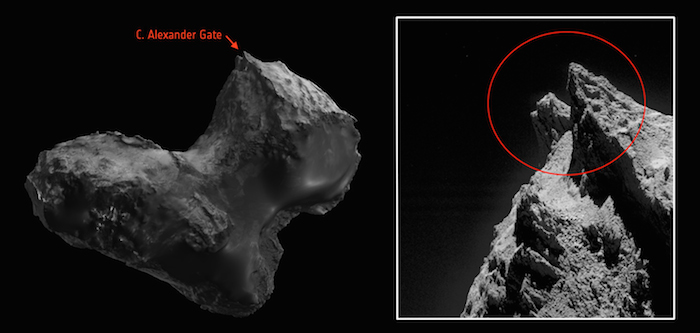
Left: from ESA's comet viewer http://sci.esa.int/comet-viewer; Right: ESA/Rosetta/MPS for OSIRIS Team MPS/UPD/LAM/IAA/SSO/INTA/UPM/DASP/IDA
-
This growing body of science and discovery has only been made possible through the dedication of hundreds of scientists and engineers across the globe, who have worked or still work on the mission.
For a project that has been going for almost 30 years, it is also regrettably inevitable that a few members of this large team have been outlived by the mission, including some who unfortunately did not live to appreciate the main comet phase.
As a token of deep gratitude and thanks, the Rosetta SWT has dedicated the upcoming special issue of scientific papers in Astronomy & Astrophysics to everyone who has worked on the mission, including those who continue to work on the mission, but especially those colleagues who have passed away.
.

Left: from ESA's comet viewer http://sci.esa.int/comet-viewer; Right: ESA/Rosetta/MPS for OSIRIS Team MPS/UPD/LAM/IAA/SSO/INTA/UPM/DASP/IDA
-
As part of this recognition, the SWT has also dedicated two features on the comet to two esteemed colleagues who have passed away in recent years.
These features are the C. Alexander Gate, found on the smaller lobe, dedicated to Dr Claudia J. Alexander, the US Rosetta Project Scientist who passed away in July this year, and the A. Coradini Gate, located on the larger lobe, after Dr Angioletta Coradini, the former Principal Investigator of the VIRTIS instrument, who passed away in September 2011.
The two features were chosen for their prominence on Comet 67P/C-G, and for their very distinctive and striking gate-like appearances, considered to be highly appropriate monuments for our absent colleagues.
---
HOW ROSETTA’S COMET GOT ITS SHAPE
This news item is mirrored from the main ESA Web Portal.
.
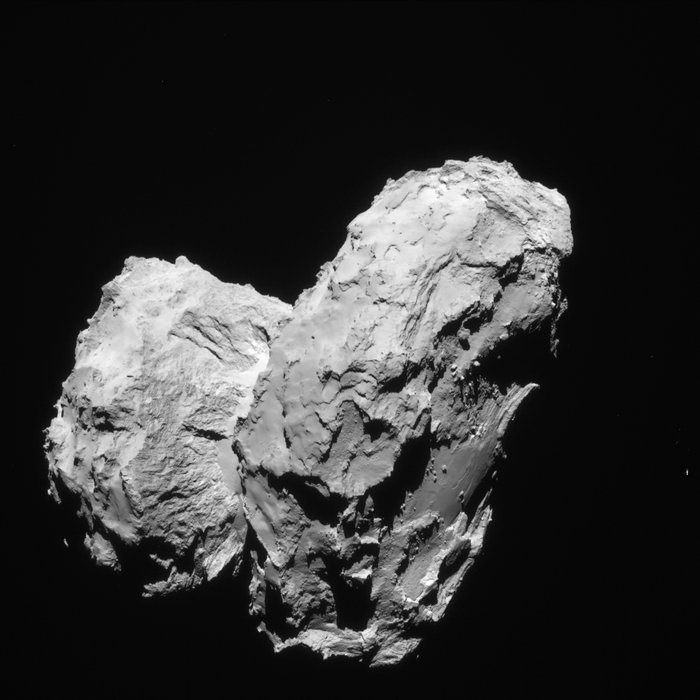
The distinctive shape of Comet 67P/C-G. Credits: ESA/Rosetta/Navcam – CC BY-SA IGO 3.0
.
Two comets collided at low speed in the early Solar System to give rise to the distinctive ‘rubber duck’ shape of Comet 67P/Churyumov–Gerasimenko, say Rosetta scientists.
The origin of the comet’s double-lobed form has been a key question since Rosetta first revealed its surprising shape in July 2014.
Two leading ideas emerged: did two comets merge or did localised erosion of a single object form the ‘neck’?
Now, scientists have an unambiguous answer to the conundrum. By using high-resolution images taken between 6 August 2014 and 17 March 2015 to study the layers of material seen all over the nucleus, they have shown that the shape arose from a low-speed collision between two fully fledged, separately formed comets.
.
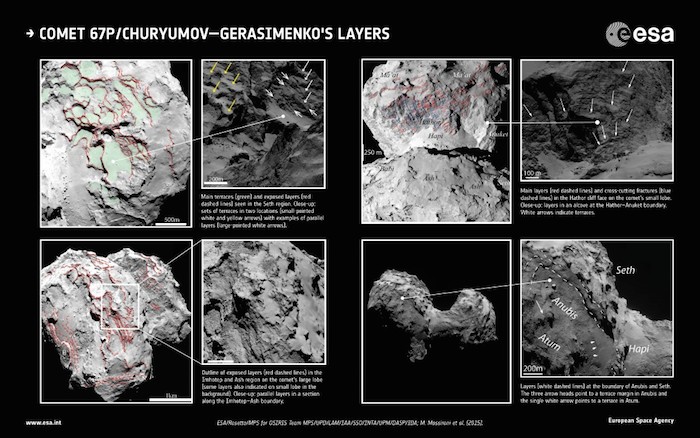
“It is clear from the images that both lobes have an outer envelope of material organised in distinct layers, and we think these extend for several hundred metres below the surface,” says Matteo Massironi, lead author from the University of Padova, Italy, and an associate scientist of the OSIRIS team.
“You can imagine the layering a bit like an onion, except in this case we are considering two separate onions of differing size that have grown independently before fusing together.”
The results of the study are reported in the journal Nature and were presented today at the European Planetary Science Congress in Nantes, France.
To reach their conclusion, Matteo and his colleagues first used images to identify over 100 terraces seen on the surface of the comet, and parallel layers of material clearly seen in exposed cliff walls and pits. A 3D shape model was then used to determine the directions in which they were sloping and to visualise how they extend into the subsurface.
It soon became clear that the features were coherently oriented all around the comet’s lobes and in some places extended to a depth of about 650 m.
“This was the first clue that the two lobes are independent, reinforced by the observation that the layers are inclined in opposite directions close to the comet’s neck,” says Matteo.
“To be sure, we also looked at the relationship between the local gravity and the orientations of the individual features all around the reconstructed comet surface.”
.
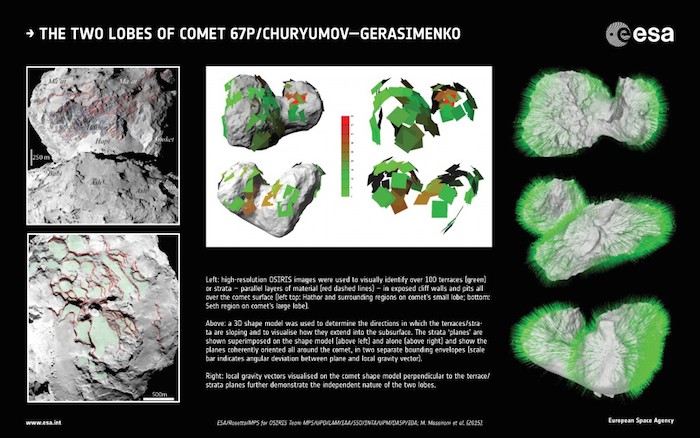
Broadly speaking, layers of material should form at right angles to the gravity of an object. The team used models to compute the strength and direction of the gravity at the location of each layer.
In one case, they modelled the comet as a single body with a centre of mass close to the neck. In the other, they worked with two separate comets, each with its own centre of mass.
The team found that orientation of a given layer and the direction of the local gravity are closer to perpendicular in the model with two separate objects, rather than in the one with a single combined nucleus.
“This points to the layered envelopes in the comet’s head and body forming independently before the two objects merged later,” concludes Matteo. “It must have been a low-speed collision in order to preserve such ordered strata to the depths our data imply.”
“In addition, the striking structural similarities between the two lobes imply that despite their initially independent origins, they must have formed through a similar accretion process,” adds co-author Bjorn Davidsson of Uppsala University, Sweden.
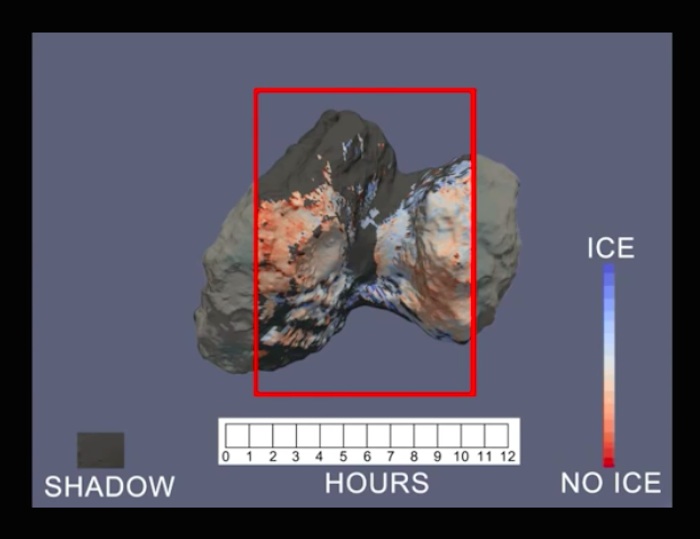
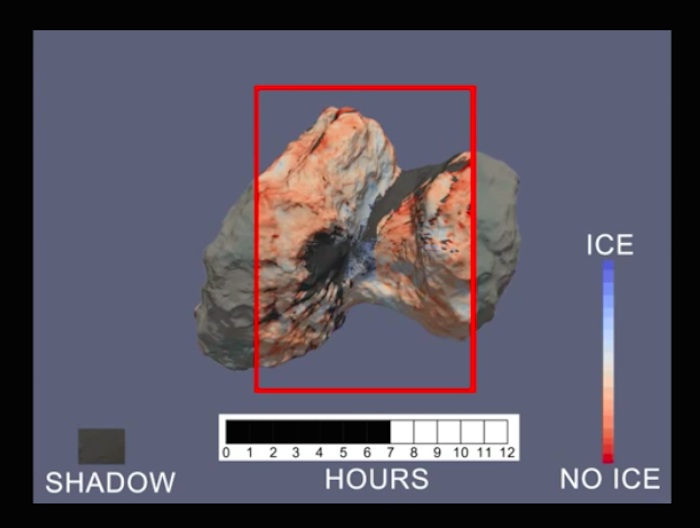
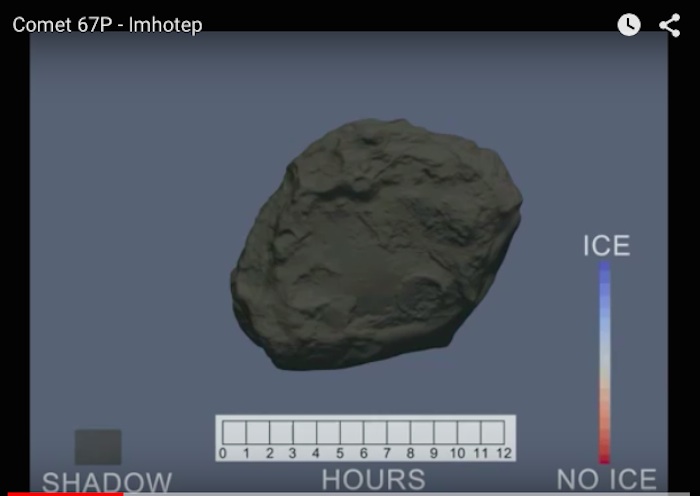
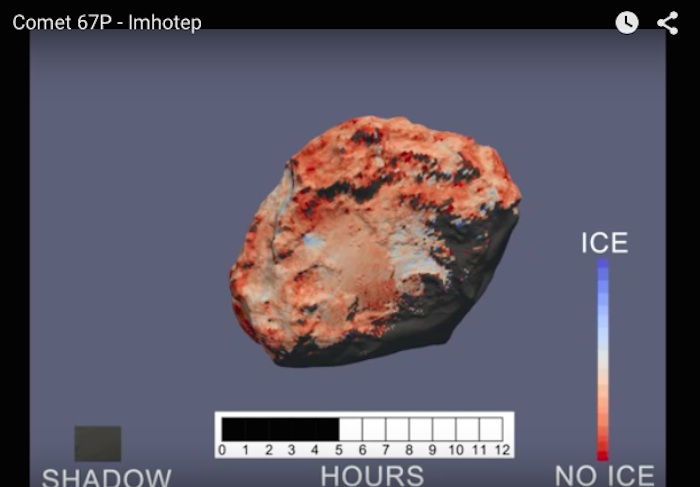


“Layering has also been observed on the surface of other comets during previous flyby missions, suggesting that they also underwent a similar formation history.”
Finally, the team note that even though erosion is not the root cause of the comet’s double-lobed shape, it nevertheless does play an important role in the comet’s evolution today.
Local variations seen in the structure of the surface likely result from different rates of sublimation – when ice turns directly into a gas – of frozen gases embedded within the individual layers, which are not necessarily distributed evenly throughout the comet.
“How the comet got its curious shape has been a major question since we first saw it. Now, thanks to this detailed study, we can say with certainty that it is a ‘contact binary’,” says Holger Sierks, OSIRIS principal investigator at the Max Planck Institute for Solar System Research in Göttingen.
“This result adds to our growing knowledge of the comet – how it formed and its evolution,” says Rosetta project scientist Matt Taylor.
“Rosetta will continue to observe the comet for another year, to get the maximum amount of information on this celestial body and its place in the history of our Solar System.”
“The two independent and primitive envelopes of the bilobate nucleus of comet 67P/C-G,” by M. Massironi et al., is published as Advanced Online Publication on www.nature.com today.
Dr Massironi presented the study today at the European Planetary Science Congress in Nantes, France, in a dedicated press briefing.
---
AN UPDATE ON COMET 67P/C-G’S WATER-ICE CYCLE
Last week we reported on the daily water-ice cycle of Comet 67P/Churyumov-Gerasimenko that was observed in a specific region of the comet’s neck by Rosetta’s VIRTIS instrument, in September 2014.
Yesterday at the European Planetary Science Congress, animations were shown covering the period 1 August 2014 to 10 February 2015 for two different areas of the nucleus, showing the behaviour of the water-ice over a much longer period.
“We are now able to show that this cycle is common in several regions of the nucleus, depending on the illumination conditions, and hence further demonstrate that the proposed cycle is a general mechanism of water transport from depth to the surface acting on comets,” said Fabrizio Capaccioni, VIRTIS principal investigator. Fabrizio described the results in a press briefing held at EPSC yesterday afternoon.
.


The two movies are based on data acquired between 1 August 2014, when the comet was at a distance of about 542 million km (3.62 AU) from the Sun and 10 February 2015, when the comet was 352 million km (2.35 AU) from the Sun. They show the ice abundance at each time during the comet's 12.4 hour day for two different regions: one focused on the Imhotep region on the comet’s large lobe, the other around the comet’s neck. For each timestamp, each data point represents the average, for a particular hour of the comet day, over the entire timeframe August-February.
The blue regions indicate the presence of ice in the uppermost surface layer, red shows no ice, and grey indicates portions of the comet that were in shadow.
.



“We see that in many areas on the comet's surface the bluer regions have a short lifetime, appearing just after dawn and disappearing a few hours later,” says Fabrizio. “This indicates that in these areas the ice is not stable at the surface but is deposited during the night and sublimates away during the day. This is a clear confirmation of the proposed water-ice cycle.”
The movies also show areas where the bluish colour is persistent throughout the day, which Fabrizio explains as regions of permanent ice – these will be the subject of a future study.
Presentations on the comet’s water-ice cycle will also be given as part of the Rosetta scientific sessions at EPSC later this week, for example: Temporal variability of 67P/Churyumov-Gerasimenko nucleus spectral properties from VIRTIS-M onboard Rosetta by M. Ciarniello et al.
---
ROSETTA’S FIRST PEEK AT THE COMET’S SOUTH POLE
Using the Microwave Instrument for the Rosetta Orbiter (MIRO), scientists have studied the comet's southern polar regions at the end of their long winter season. The data suggest that these dark, cold regions host ice within the first few tens of centimetres below the surface in much larger amounts than elsewhere on the comet.
Since its arrival at Comet 67P/Churyumov-Gerasimenko, Rosetta has been surveying the surface and the environment of this curiously-shaped body. But for a long time, a portion of the nucleus – the dark, cold regions around the comet's south pole – remained inaccessible to almost all instruments on the spacecraft.
Due to a combination of its double-lobed shape and the inclination of its rotation axis, Rosetta's comet has a very peculiar seasonal pattern over its 6.5 year-long orbit. Seasons are distributed very unevenly between the two hemispheres, each of which comprises parts of both comet lobes and of the 'neck'.
For most of the comet’s orbit, the northern hemisphere experiences a very long summer, lasting over 5.5 years, and the southern hemisphere undergoes a long, dark and cold winter. However, a few months before the comet reaches perihelion – the closest point to the Sun along its orbit – the situation changes, and the southern hemisphere transitions to a brief and very hot summer.
When Rosetta arrived at 67P/C-G in August 2014, the comet was still experiencing its long summer in the northern hemisphere and regions on the southern hemisphere received very little sunlight. Moreover, a large part of this hemisphere, close to the comet’s south pole, was in polar night and had been in total darkness for almost five years.
With no direct illumination from the Sun, these regions could not be imaged with Rosetta’s OSIRIS science camera. In addition, their low temperatures – ranging between 25 and 50 degrees above absolute zero – did not allow observations with VIRTIS, the Visible, InfraRed and Thermal Imaging Spectrometer, either.
For the first several months after Rosetta’s arrival at the comet, only one instrument on the spacecraft could observe and characterise the cold southern pole of 67P/C-G: the Microwave Instrument for the Rosetta Orbiter (MIRO).
In a paper accepted for publication in the journal Astronomy and Astrophysics, scientists report on the data collected by MIRO over these regions between August and October 2014.
“We observed the ‘dark side’ of the comet with MIRO on many occasions after Rosetta’s arrival at 67P/C-G, and these unique data are telling us something very intriguing about the material just below its surface,” explains Mathieu Choukroun from NASA's Jet Propulsion Laboratory, lead author of the study.
Observing the comet’s southern polar regions, Choukroun and colleagues found significant differences between the data collected with MIRO’s millimetre and sub-millimetre wavelength channels. These differences might point to the presence of large amounts of ice within the first few tens of centimetres below the surface of these regions.
“Surprisingly, the thermal and electrical properties around the comet’s south pole are quite different to what is found elsewhere on the nucleus. It appears that either the surface material or the material that lies down to a few tens of centimetres below it is extremely transparent at the MIRO wavelengths of 0.5 and 1.6 mm, and could consist mostly of water ice or carbon-dioxide ice,” he adds.
.

This graph shows the antenna temperatures measured by MIRO during two consecutive scans of Comet 67P/C-G's southern polar regions, performed on 23 October 2014, at millimetre (red) and sub-millimetre (blue) wavelengths. The series of images on the top, obtained from the digital shape model of the comet, show the various portions of the nucleus that were surveyed in these scans. The grey shaded area in the graph indicates a calibration interruption of the data. From M. Choukroun et al., Astronomy & Astrophysics, 2015.
.
The difference between the surface and sub-surface composition of this part of the nucleus and that found elsewhere might originate in the comet’s peculiar cycle of seasons. One of the possible explanations is that water and other gases that were released during the comet’s previous perihelion, when the southern hemisphere was the most illuminated portion of the nucleus, condensed again and precipitated on the surface after the season changed and the southern hemisphere plunged again into its long and cold winter.
These are, however, preliminary results, because the analysis depends on the detailed shape of the nucleus, and at the time the measurements were made the shape of the dark, southern polar region was not known to great accuracy.
“We plan to revisit the MIRO data using an updated version of the digital shape model, to verify these early results and refine the interpretation of the measurements,” adds Choukroun.
Besides, Rosetta scientists will be testing these and other possible scenarios using data that were collected in the subsequent months, leading to the comet's perihelion, which took place on 13 August 2015, and beyond.
In May 2015, the seasons changed on 67P/C-G and the brief, hot southern summer, which will last until early 2016, began. As the formerly dark southern polar regions started to receive more sunlight, it has been possible to observe them with other instruments on Rosetta, and the combination of all data might eventually disclose the origin of their curious composition.
“In the past few months, Rosetta has flown over the southern polar regions on several occasions, starting to collect data from this part of the comet after summer began there,” explains Matt Taylor, ESA Rosetta project scientist.
“At the beginning of the southern summer, we had a paucity of observations in these regions as Rosetta's trajectory focussed on the northern hemisphere due to ongoing communication with the lander, Philae. However, closer to perihelion we were able to begin observing the south.
“Rosetta is currently on an excursion out to 1500 km from the nucleus to study the comet's environment at large, but it will soon come closer to the comet, focussing on full orbits to compare the northern and southern hemispheres, as well as some slower passes in the south to maximise our observations there. In addition, as activity will start to wane later this year, we hope to get closer to the nucleus and gain higher resolution observations of the surface.”
Mark Hofstadter, MIRO Principal Investigator at NASA's Jet Propulsion Laboratory, describes the result as “a great example of how the scientific process unfolds as Rosetta is studying the evolution of this comet up close.”
“First, we observed these dark regions with MIRO, the only instrument able to do so at the time, and we tried to interpret these unique data. Now, as these regions became warmer and brighter around perihelion, we can observe them with other instruments, too,” he adds.
“We hope that, by combining data from all these instruments, we will be able to confirm whether or not the south pole had a different composition and whether or not it is changing seasonally.”
Quelle: ESA
4612 Views
